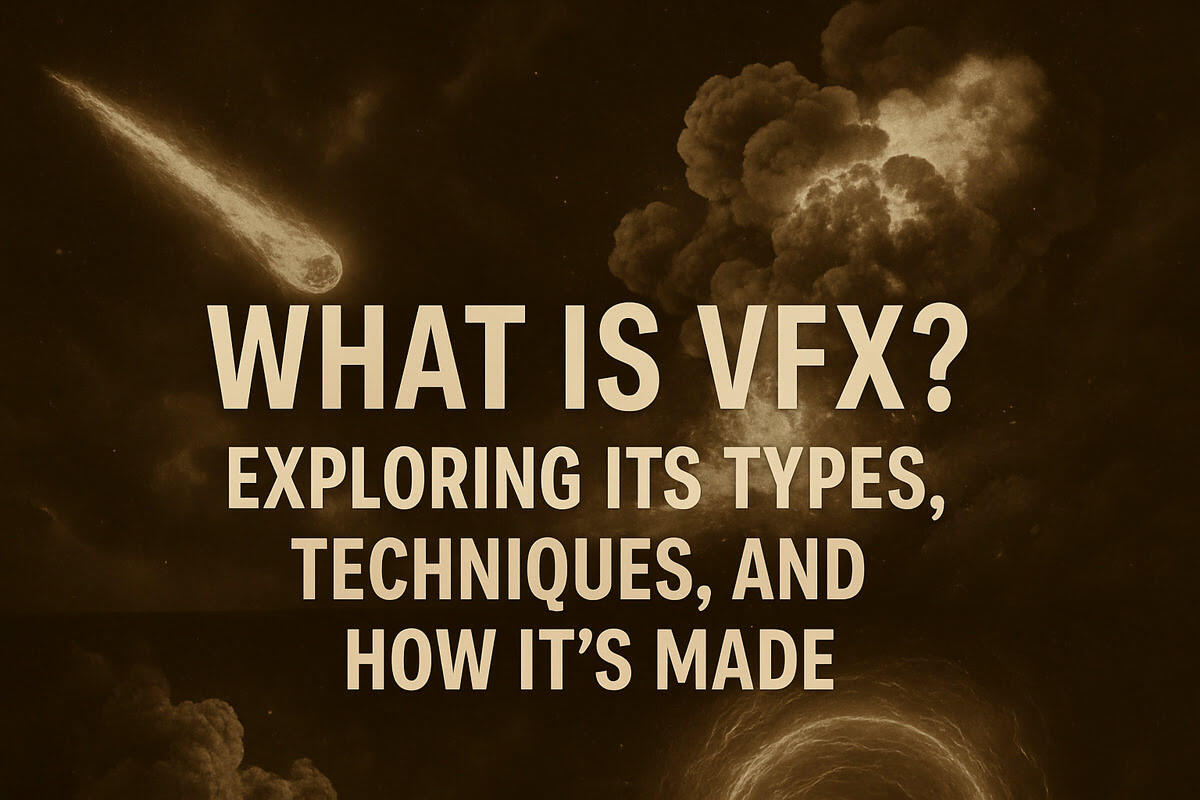
What is VFX? Exploring Its Types, Techniques, and How its Made
What is VFX: Visual effects, commonly abbreviated as VFX, play a crucial role in the modern entertainment industry. They allow filmmakers to create awe-inspiring visuals, bring imaginative worlds to life, and enhance the narrative experience. But what exactly is VFX? How does it work, and what makes it different from other forms of visual enhancements like CGI or SFX?
In this article, we will dive deep into the meaning of VFX, its various types, the process of creating it, and its role in films, including examples of its use. We will also explore key topics such as VFX vs. CGI vs. SFX, the concept of VFX animation, and a lot more.
What is VFX?

VFX stands for Visual Effects. It refers to the process of creating, altering, or enhancing imagery in a way that would be difficult, if not impossible, to achieve during actual filming. VFX can involve everything from digitally creating environments and characters to simulating natural phenomena like fire, rain, or explosions. Creators typically use it in post-production to enhance scenes and add elements impossible to film.
Moreover, The VFX meaning can be further broken down into digital manipulation of images to create stunning visuals. Whether it’s in the form of CGI (Computer-Generated Imagery), compositing, motion capture, or digital effects, VFX allows filmmakers to push the boundaries of their stories and create visual experiences that captivate audiences.
The VFX full form is simply Visual Effects, but it is often confused with SFX (Special Effects), as both aim to manipulate reality in films, though in very different ways.
Also Read: Top 15 Influencer Marketing Agencies in India
Types of VFX
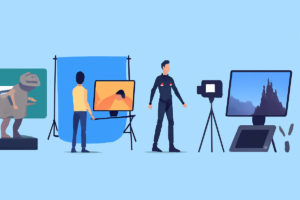
There are several different types of VFX that are used in the filmmaking process. These include everything from generating CGI characters to compositing and even crafting completely new environments. Hence, Below are some of the most widely used types of VFX in filmmaking:
1. CGI (Computer-Generated Imagery)
CGI is among the most well-recognized forms of VFX. It involves creating 3D models of objects, creatures, or environments using computer software. Artists animate and render these digital creations to produce the visual effects seen in the film. Some of the most iconic examples of CGI in movies include the dinosaurs in Jurassic Park, the Hulk in The Avengers, and the fantastical creatures in Avatar.
2. Compositing
Compositing involves merging various visual elements to form a unified scene. This often includes layering multiple images or video clips, such as inserting an actor shot in front of a green screen into a digital backdrop. A well-known example of compositing is the work done in The Matrix, where the famous bullet-dodging scene was achieved by compositing CGI effects with live-action footage.
Also Read: What is a Feature Film? Definition, Categories, and How It’s Made
3. Motion Capture (MoCap)
Motion capture, or MoCap, involves recording an actor’s physical movements and translating them into digital form to animate CGI characters. This technique is essential for creating realistic digital characters with human-like movements. Films such as The Lord of the Rings utilized motion capture to animate Gollum, while more recent movies like Avatar employed the technique to craft lifelike movements for the Na’vi characters.
4. Matte Painting
Matte painting is the method of designing digital backdrops, typically used to expand a set or build environments that would be too costly or unfeasible to film in reality. For example, the massive cities in Blade Runner 2049 were created using matte paintings to give the illusion of a futuristic, sprawling metropolis.
What is VFX in Movies: Key Examples
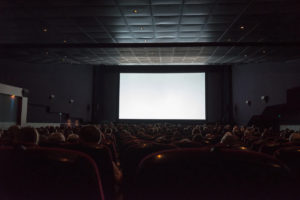
Now that we have explored the types of VFX, let’s take a look at some famous VFX examples in movies. These films showcase the power and scope of visual effects in movies, demonstrating how VFX artists bring stories to life in ways that would be impossible with traditional filming methods.
1. Jurassic Park (1993)
Jurassic Park revolutionized the film industry with its CGI dinosaurs, which were created using groundbreaking VFX technology. The film combined practical effects, animatronics, and CGI to create some of the most memorable scenes in cinematic history. The VFX artists behind the film brought dinosaurs to life in a way that had never been seen before, setting the bar for future films.
2. Avatar (2009)
Avatar took VFX to new heights by using cutting-edge motion capture technology and CGI to create the entire world of Pandora. The visual effects in Avatar were not only stunning but immersive, allowing audiences to experience the fantastical world in a fully realized way. The combination of 3D technology, digital landscapes, and VFX was groundbreaking at the time.
Also Read: Top 15 Famous Film Directors in India
3. The Avengers (2012)
The VFX in The Avengers is a prime example of how CGI and motion capture are used together to create realistic characters and action scenes. The Hulk, for example, was entirely created through CGI and motion capture, with the movements of actor Mark Ruffalo translated into the digital Hulk character. The battle scenes in the movie were also enhanced with VFX, including CGI explosions and digital set extensions.
4. The Matrix (1999)
One of the most famous examples of VFX in film history is the bullet-dodging scene in The Matrix, where VFX artists used a combination of CGI and compositing to create the illusion of time slowing down. The film made “bullet time” iconic, and it remains a popular pop culture reference today.
5. The Lord of the Rings Trilogy (2001–2003)
The filmmakers of The Lord of the Rings trilogy used VFX to build entire worlds and create digital characters. They used motion capture to bring Gollum to life and CGI to generate hordes of orcs and other creatures. They also crafted landscapes like the digital city of Minas Tirith using a combination of matte painting and CGI.
6. Gravity (2013)
Gravity made extensive use of VFX to create realistic space environments and zero-gravity effects. The film’s stunning visuals were achieved through a combination of CGI for the spacecraft and Earth backgrounds, along with digital simulations of astronaut movements and space debris. The film’s visuals contributed greatly to its immersive experience and critical acclaim.
7. Inception (2010)
Christopher Nolan’s Inception featured some of the most impressive VFX work in modern filmmaking, particularly in the iconic rotating hallway fight scene. The scene was achieved using a combination of physical sets and CGI, allowing for the surreal, gravity-defying action to take place. Filmmakers used digital effects to bend cityscapes, enhancing the film’s dream-like atmosphere.
Also Read: Animation in Advertising: Best Animated Ads Examples, Types and Benefits
8. Interstellar (2014)
Another of Christopher Nolan’s films, Interstellar used Visual effect to bring to life the vast, alien planets and the wormhole. The film’s VFX accurately depicted a black hole using real physics, earning praise for its stunning realism.
9. The Lion King (2019)
The Lion King (2019) used VFX and CGI to bring the beloved animated characters and world to life in photorealistic detail. The movie’s visual effects brought animals and environments to life, skillfully merging animation with live-action to capture the spirit of the original animated classic.
10. Star Wars: The Force Awakens (2015)
The Force Awakens helped revive the iconic franchise with stunning digital effects. From the CGI creation of creatures like the Rathtar to space battles and expansive environments, Visual effects helped build on the legacy of the previous Star Wars films, continuing the saga with next-generation visual effects that paid homage to the series’ pioneering work in visual storytelling.
Difference Between Special Effects vs. Visual Effects
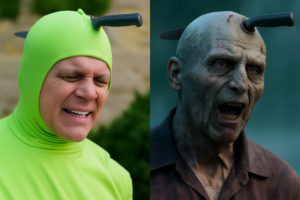
VFX vs. CGI vs. SFX
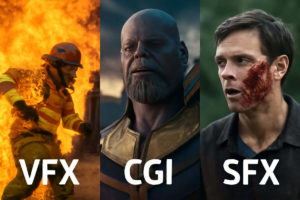
While VFX encompasses all visual effects, CGI (Computer-Generated Imagery) is a specific type of VFX that involves creating images using computer software. SFX, as mentioned earlier, refers to practical, on-set effects.
- VFX is a broader term that includes all digital visual effects, including CGI and other techniques.
- CGI is a subset of VFX, focusing specifically on computer-generated imagery.
- SFX involves practical effects on set, such as explosions or makeup effects.
Also Read:Top 10 Social Media Marketing Agency in Delhi
What is VFX Animation?
VFX animation involves blending animation techniques with Visual effects produce realistic, fluid movements within digital settings. Artists animate objects or characters into real scenes to enhance visuals with movement and transformation.. These animations are common in films, TV shows, and video game-s, particularly for digital characters or fantastical scenes.
For example, animated creatures in movies like Shrek or The Lion King rely on VFX animation to bring them to life, giving them realistic movement and interaction within their environments.
Common VFX Software Examples:

1. Autodesk Maya
Autodesk Maya is one of the most popular and versatile VFX software used in the industry. Artists primarily use it for 3D modeling, animation, and rendering. Maya is essential for creating complex digital assets, character animations, and effects that integrate seamlessly into live-action footage.
2. Adobe After Effects
Adobe After Effects is the go-to software for compositing, motion graphics, and 2D animation. It’s widely used for visual effects in films, television, and commercials. After Effects allows Visual artists to combine different visual elements, create effects, and add final touches to a scene.
3. Houdini
Houdini is known for its advanced particle effects, dynamics simulations, and procedural generation of complex visual effects. It extensively simulates realistic effects such as smoke, fire, water, and explosions.
4. Nuke
Nuke is a robust node-based compositing tool widely used for digital compositing and integrating VFX elements. It allows VFX artists to combine multiple visual elements, track objects, and fine-tune scenes to make everything fit together naturally.
5. Cinema 4D
Cinema 4D is a 3D design tool that creates, animates, and renders digital models and visual effects. With its user-friendly interface and high-quality output, it has become a popular choice among VFX artists for creating motion graphics and 3D designs.
6. ZBrush
ZBrush is used for high-resolution 3D modeling, especially for organic models such as characters or creatures. It is favored by VFX artists working on digital sculptures and detailed textures.
7. RealFlow
RealFlow is a software used for simulating fluid dynamics and particle systems. Artists commonly use it to generate realistic simulations of water, liquids, and gases for films and visual stories.
Also Read: Top Digital Marketing Agencies in India 2025
FAQs
- What is VFX in movies?
VFX in movies refers to the digital manipulation and enhancement of images and scenes to create visuals that cannot be achieved through traditional filming. - What is the SFX full form?
The SFX full form is Special Effects, which refers to practical effects used on set, such as explosions, makeup, or animatronics. - What are FX and VFX?
FX is a shorthand for both SFX (Special Effects) and VFX (Visual Effects). SFX pertains to tangible, on-set effects, whereas VFX involves digital effects that are crafted in post-production. - What are some VFX examples in movies?
Some examples include CGI dinosaurs in Jurassic Park, motion capture for Gollum in The Lord of the Rings, and the bullet-dodging scene in The Matrix. - What does a VFX artist do?
A VFX artist is responsible for creating and integrating visual effects into a film, including tasks like designing digital creatures, creating CGI environments, and compositing digital and live-action elements.
Conclusion
In conclusion, Visual effect is an essential component of modern filmmaking, transforming the way stories are told in movies, TV shows, and video games. Whether through CGI, motion capture, or compositing, Visual effects allows filmmakers to create worlds, characters, and environments that are beyond the limits of reality. It plays a crucial role in shaping the entertainment industry, pushing creative boundaries and enhancing audience experiences.
The world of VFX continues to evolve, with advancements in real-time rendering, virtual reality, and augmented reality shaping the future of visual storytelling. From visual effects in films to cutting-edge visual animation, VFX opens limitless possibilities, showcasing the technical and creative effort behind the visual magic we experience on screen. By understanding the meaning, types, techniques, and production process of VFX, we gain a deeper appreciation for its impact.